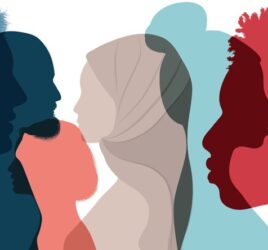INTRODUCTION
Thank you to MICN for inviting me to share with you on MIGRATION, DIASPORA, and INTERNATIONAL CHURCHES. I have known about this network from its very infancy – because I knew some of the pioneers of MICN quite intimately.
It seems that the whole world’s population is on the move! Since the dawn of the 21st Century we have witnessed an unprecedented surge in migration worldwide. We have witnessed world wide population shifts on a mega scale. People are crossing national borders for many reasons i.e. transnational migration is now a reality.
I am going to share with you three important dimensions about transnational migration.
1. Transnational migration is truly a global phenomenon
No one can deny the reality nor can everyone escape the reality that transnational migration is occurring at an accelerated pace. And it is occurring on an unprecedented scale. Therefore, transnational migration is a demographic reality that no one can ignore, because it is now a global reality. This is a reality that no community can avoid and no country can be immune to it.
In a world more inter-connected than ever before, the rate of migration will only speed up. We can claim that on our planet, distance is dying. We are truly living in the Age of Migration! This explains why the United Nations Secretary-General Antonio Guterres urged world leaders in January 2018 “to celebrate global Migration as a positive global phenomenon.”
2. Transnational migration is multidirectional
For a long time, the migration of people was from people from the South and East moving to the North and West. But in the last 30 years transnational migration is occurring at unpredictable speed and in all directions. We are witnessing massive polycentric migration. Now people are moving from everywhere to everywhere. And people are moving in all directions.
- Eg.1 For Koreans, the United States was the country of choice in the post–Second War decades. Now Koreans go all over the globe – Europe, the Philippines, Australia, South Africa.
- Eg.2 Nepalis/Bangladeshis move to India, Malaysia, Hong Kong, Indonesia. Transnational migration is truly multidirectional. Nowhere is it more evident than at international airports. You have seen it yourself. Almost every single day, international airports are showcases of transnational migration.
3. Transnational migration is transformational
This great flow of people around the world is drastically changing many important aspects of societies.
- Transnational migration has never been as pervasive as it is now. It is seen as an uncontrollable change agent of society. It is changing the social, cultural, religious and even political landscapes of cities, communities, countries and continents.
- Transnational migration helps in releasing creative energies and adaptions, creating new realities and it causes people to intermingle with other people.
- Transnational migration is causing the development of a diasporic consciousness which produces confusion, pain, conflicts and even serial migration.
WHAT ARE THE REASONS FOR THIS PHENOMENON OF TRANSNATIONAL MIGRATION?
The motivations to move and the factors causing displacement of people fluctuates considerably. These depend upon the people group, the time of migration, the socio–economic conditions in both countries, arranged marriage alliances or because of family sponsorships.
Some move for SAD reasons, because of man–made disasters. Some are forced to flee when their lives or livelihoods are threatened and some seek refugee status in foreign countries. Sad reasons include:
- Sustained civil war (Eg. 5.6 million Syrians are registered refugees).
- Economic collapse (Eg. Four million Venezuelans left their native land).
- Ethnic cleansing (Eg. Rohingya refugees – one million stranded in Bangladesh).
- Political oppression (Eg. Five million Afghans are expected to leave Afghanistan in the next two years).
- Religious persecution (Eg. Tibetans moved to India with their Dalai Lama now headquartered there).
- Natural disasters like earthquakes, tsunamis, volcanic explosions and climate change (Eg. 200 million to be displaced by 2030).
All these natural disasters have caused many to flee out of sheer necessity.
All of these affected people are trying to survive somehow in their new environments.
Many, many people are also moving for good reasons. Thousands around the world plan in advance to move to greener pastures to pursue improving their academic credentials and subsequently to ensure economic advancement. These are attracted by the possibilities of greater freedom and better living conditions.
Three Major Consequences of Migration:
Consequence #1 – Almost ALL countries are impacted by migration.
Some countries are impacted more than others. However, there is no shoreline that remains unaffected by migration. There are two categories of countries that relate to migration.
1.1 Some massive Diaspora exporting countries include China, Philippines, India, Bangladesh, Palestine, Mexico, Nepal, Ghana and the South Pacific Islands.
1.2 Some are Diaspora importing countries. These importing countries like US, Canada, Germany, Australia, UK receive more immigrants than other countries. These Western countries need to boost their economies and so they encourage immigration. Other countries like Singapore, South Korea and in the Gulf region offer low-skilled and low wage jobs.
Consequence #2 – Almost all countries are taking in more diaspora people than most of their citizens realize.
Eg. 1. Syrian refugees that penetrated Europe (1.3 million just in 2015)
Eg. 2. Philippines – more international university students in Davao City in Mindanao than more Filipinos know about. More than 5000 Indian students are studying medicine in the City of Angeles in Central Luzon, Philippines.
Consequence #3 – The volume of recorded remittances by Diaspora people to developing countries has soared over the last three decades.
The term “remittance” refers primarily to the money migrants send back to their family in the country of origin. These remittances enable migrant families to achieve a higher standard of living.
Global remittances have continued to increase. In the early 1990’s remittances totalled less than $50 billion annually. According to the World Bank in 2016 it became $US 442 billion went to developing countries. In 2019 it was $US 528 billion that went to developing nations, which is an $US 86 billion increase in three years. And in 2020, it was $US 540 billion – a drop of only 1.6 percent from 2019 despite the COVID pandemic conditions.
THREE EMERGING REALITIES OF MIGRATION
Reality #1 – Gains in Hyper Mobility
Just think about it! In less than 100 years we have witnessed massive changes in mobility. We have gone from horse – drawn carriages, to automobiles, to planes. Multi-billion dollars are being invested in emerging trends of technologies, industries and markets to increase mobility. What is the impact of all this investment? This is giving rise to new products and services that will sharply reduce the cost of moving people, goods and information. We are already moving faster than ever before. But we are soon going to move much, much faster.
Two examples that are going to increase mobility and thereby speed up transnational migration.
Eg 1. Soon we will have Hyperloop Trains.
These are trains that travel in vacuum tubes travelling at supersonic speeds. These Hyperloop Trains will enable us to travel at 800 miles per hour. What will that do? For example, the travel time from New York City to Washington DC will be reduced to just 27 minutes and you will not have to fight traffic. Just imagine this? The travel time from Shanghai to Hong Kong will only be 1 hour 27 minutes. All of this means that over the next 20 years, the cost of distance will decline sharply. This will alter the way we live. However, this will also speed up migration.
Eg. 2. The introduction of High-Speed Rail.
The largest infrastructure project on planet Earth is the construction of the NEW SILK ROAD. This is the ONE ROAD – ONE BELT INTIATIVE of China to connect Eastern China to Western Europe with high-speed rail. Trillions of dollars are being invested in infrastructure for this. This will save several days in transporting goods from Chinese factories to showrooms in Europe. And this will obviously generate billions of dollars in revenue for China. But the greatest impact of these high-speed trains will be the migration of people. It is projected that by 2050 about 100 million Chinese will migrate to Central Asia, Middle East and Europe. It is possible to have a high percentage among the Chinese migrants being Christians.
Reality #2 – Gains in Hyper Connectivity
It is a fact that more and more satellites are being launched into outer space. Why? In order to help us to communicate and network with each other better. With this communication will be greatly accelerated. This means transnational communication will be easier and faster. We will be connected more and more with each other. E.g. We are now able to send money through mobile devices. I am convinced that we will be able to talk absolutely FREE to anyone anytime. The more we are connected, the more the desire to move and meet each other. This also means there will be greater desire to migrate.
Reality #3 – Gains in Language Translation
Soon we will have smartphone – based translation apps that will provide LIVE TRANSLATION across some 100 languages. This will enable the languages and culture barriers to come down quickly. Therefore, there will be greater and greater interaction between people across the street and around the world.
TRANSNATIONAL MIGRATION CREATES DIASPORA PEOPLES
One of the inevitable consequences of transnational migration is the creation of DIASPORAS or DIASPORA PEOPLES. DIASPORA refers to any community whose members settle outside their native land and maintain some connection with the “old country”. The term DIASPORA also applies to groups whose members are widely scattered around the world and share common values. They often face some special barriers to integration into their host nations.
Diaspora is a historic phenomenon. People have moved from the beginning of time. However, in the last 300 years we have seen some massive migrations.
Eg 1. Because of Ireland’s great famine of the 1840’s it created the Irish Diaspora.
Eg 2. The slave trade of the European colonists created the African Diaspora.
Eg 3. The Indian Diaspora began in the late nineteenth century with indentured labourers recruited for the colonial plantations in Fiji, South Africa, Malaya and the Caribbean Islands. There are 35 million Indians in Diaspora.
Eg 4. The Armenian Diaspora was the result of the slaughter of an estimated 1 million people in 1915
Eg 5. Today, there are approximately 50 million Chinese in Diaspora
Thailand – 9.3 million
Indonesia – 7.0 million
Australia – 1.2 million
S. Korea – 1 million
France – 600,000
UK – 400,000
South Africa – 300,000
Germany – 136,000
Eg 6. There are 13 million Filipinos in Diaspora
USA –3.4 million
Saudi Arabia – 950,000
Canada –900,000
Japan – 325,000
Qatar – 250,000
Italy and Singapore each have 175,000
Norway – 18,000
Eg 7. About 35 million Indians are in Diaspora
USA – 3.5 million
Malaysia – 2.9 million
Canada 1.6 million
Singapore – 800,000
Australia 700,000
10 percent of the overall population of Saudi Arabia are Indians and 3.5 million Indians are in the UAE.
The United Nations reports that there are 281 million diaspora people today; i.e. three percent of the world’s population. This number is projected to reach 350 million by 2030.
FOUR OBSERVATIONS OF DIASPORA PEOPLES
1. Diaspora peoples exhibit a heightened religious consciousness during their migration and in their new diasporic settings.
Sufficient research is available to show that migrants cherish their religious connections and experiences in times of transition. Religion forms a powerful anchor for them in the midst of massive changes of their new environment – weather, culture, isolation from family, etc.
2. Diaspora people are more receptive to Christianity in their host countries.
Q: Why does this happen
New environments give a new freedom.
New environments make them open to new ideas.
Eg. Book of ACTS – Most who came to Christ lived far away from home.
Nearly 50 percent have a Christian heritage. Some of the migrants are nominal Christians and they need to receive JESUS as Lord and Savior. Some are Roman Catholic or Orthodox and they need to be presented with the adventure of being a true disciple of Jesus. Many are believers in Christ and we need to receive them as fellow members of the family of God and help them walk their journey of faith as fellow disciples of Jesus in the host nations.
4. Diaspora Churches (Immigrant/Migrant) are being planted in diasporic settings.
By Diaspora Churches/Immigrant churches/Migrant churches. I mean they are ethnic specific, language specific…or culture specific… or a combination of them in the congregation. The First Generation needs Diaspora churches for socialization, enjoy speaking their language freely, enjoy their jokes or exchange political news from back home. Diaspora churches also allow the migrants to worship God in their own heart languages. I am sure you would agree that it is more meaningful for any one of us to worship in our own heart language.
Broadly speaking, the International Church is a “Diaspora Church.” The International Church is especially unique “Diaspora Church” in several ways:
1. Most of the attenders of International Churches are expats who are foreign passport holders and are often have all or portion of their salary paid from abroad.
2. Most of the attenders of International Churches have different nationalities, different ethnicities and different denominations.
3. Most International Churches have a great turnover in membership and lay leadership. I like what one veteran International Church pastor so aptly said: “It is like pastoring a parade.”
4. Most International Churches have conducive public worship sites to gather for worship and other ministries.
5. Most International Churches use one language for worship services, e.g., English or French.
6. Most International Churches are established in major cities of the world.
In my travels around the world, I have observed there are often more than one diaspora people group where International Churches are located. I believe that the International Church is strategically positioned to relate missionally with Diaspora Peoples:
Let me suggest FOUR WAYS TO ENGAGE:
First Way – Cultivate a Kingdom perspective of ministry.
We all need to constantly remind ourselves that we belong to ONE Kingdom and there is only ONE King – King JESUS. Recognize that International Churches are just one expression of the Body of Christ. Recognize the ministry of Diaspora Churches are equally valid expressions of the Body of Christ. To cast vision, communicate frequently from your pulpit that there are multiple ethnicities worshipping the same living God in many languages in your city or country.
Second Way – Enlist commitment from your church leaders to partner and collaborate with Diaspora Churches and Diaspora leaders.
As an International Church pastor, you need to identify “bridge people” in your congregation to connect with and build relationships with Diaspora Churches and their leaders. Initiate trust building initiatives with them. Trust building will be slow but will pay handsome dividends later.
• Go out for a meal together with the pastor.
• Feature a music team for a service.
• Invite someone who found Christ in his diaspora journey to share in your service.
Third Way – Empower and equip Diaspora Churches and its leaders.
My research shows that most of the Diaspora Churches are from the Majority World. Most Diaspora Churches are vernacular language specific or ethnic specific congregations, and they may not be fluent in English. And most of the pastors are lay pastors and they are bivocational. You will also find that most of the pastors have had no formal pastoral training. Most of the Diaspora churches are independent with little affiliation to other churches or fellowships.
International Churches are pregnant with expertise and experience in their respective congregations. Here are some topics you can offer:
• Communicate to the Diaspora leaders that you are willing to equip them and also learn from them
• Communicate to the leaders – that you want them to develop to be effective leaders of healthy churches
• Share with them that you are willing to help them
• How to prepare Bible-based sermons
• Share your library with them
• Ways to disciple others
• How to lead a team and not be a lone ranger
• How to develop an effective Board
• Many, many other topics
Fourth Way – Be missional to the Diaspora peoples within the city and country
In Diaspora Missiology we focus on four primary dimensions:
1. To the Diaspora – Evangelism and discipleship of Diaspora peoples in your current Jerusalem.
2. Through the Diaspora – Mobilization to reach their kinsmen locally and globally.
3. Beyond the Diaspora – Mobilization to reach cross-culturally beyond their Diaspora people
4. With the Diaspora – Partnership in mission globally.
To… Through… Beyond… With. I am convinced that every International Church could at least focus on the first two dimensions – To the Diaspora and Through the Diaspora.
In my research I have discovered that most Diaspora Churches are fellowship rich and missionally poor. Sad to say that this is a global phenomenon. There may be individuals in your congregations who could be tapped to focus in reaching one or two Diaspora people groups.
Here are some things you can easily do:
• Start a Diaspora focused prayer group.
• Find language specific Bibles, literature, videos, etc., that can be distributed.
• Offer English as Second language classes to Diaspora Churches.
• Mentor a Diaspora leader.
• Many more things could be attempted
In your desire to reach the Diaspora peoples you likely can be catalytic and stir the Diaspora Christians and churches to reach their own – locally and globally.
T.V. Thomas
Dr. T.V. Thomas originally from Malaysia, based in Regina, Canada is an Alliance evangelist and educator. He has engaged in transnational and trans-denominational itinerant ministry for over four decades. He has also provided visionary and pioneering leadership to several movements nationally and globally. (tvthomasglobal@gmail.com)
“Copyright 2021”



